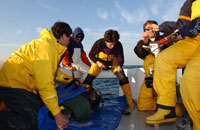Dr. Steve Wilson and Robbie Schallert tag a giant bluefin
in Port Hood, Nova Scotia
The TAG team is up in Canada where we’ve had an epic 5 days
of nonstop bluefin tagging. I’m Ethan
Estess from the Monterey Bay Aquarium and Stanford University’s Tuna Research
and Conservation Center, here with TAG scientists Robbie Schallert and Dr.
Steve Wilson of Stanford University. We came to Port Hood, Nova Scotia on
September 27th to work with Mike Stokesbury’s team from Acadia University
to study giant bluefin in the Gulf of Saint Lawrence.
TAG team Dr. Steve Wilson, Robbie Schallert (center), and Cpt. Dennis
Cameron (at head irrigating the gills)
We awoke on the 28th to flat calm seas and sunny
skies. The Tag-A-Giant team headed out with Captain Dennis Cameron and Craig of
the Bay Queen IV and Bernie and Steve
of the Carrie Anne. The bait had barely hit the water when we
hooked up on a giant bluefin tuna. An
hour later the 270cm fish was on the tagging mat and a minute later it was back
out the door, outfitted with an acoustic and pop-up archival tag (PAT). These tags will help unlock the mysteries of
bluefin migratory patterns and spawning cycles, providing critical information
for their management and conservation.
To date most of these Canadian giants have been tracked to the Gulf of
Mexico spawning grounds, but a few (less then 2%) make their way to the Mediterranean
Sea.
A giant bluefin being reeled in by the crew of the Bay Queen IV
The bluefin were there in force to feed on the large schools
of herring in the region. We double
tagged 6 fish with acoustics and pop-ups, and many of these fish were the
largest I've seen. All of Sunday’s fish
were over 260cm, easily weighing 800 pounds or more. These fish were extremely well fed and very
big around!
Measuring the length of a giant bluefin
Over the next 3 days we deployed 14 more electronic tags in
perfect fishing conditions. Cape Breton
is one of the most beautiful places I’ve ever been and we were surrounded by spectacular
wildlife. Hundreds of pilot whales, or
“blackfish” as our captain called them, circled our boat throughout. They were there for the same reason the
bluefin were- to feed on the massive schools of herring spawning along the
island. Gannets dive-bombed and grey
seals bobbed along with curious glances towards our bait. One of the highlights of the trip was placing
a tag in the largest giant bluefin TAG has ever tagged- a 313cm bluefin we
tagged and released. This behemoth
barely fit on the deck of the Day Queen
IV. This fish is surely a spawner,
and hopefully its PAT tag will teach us about bluefin spawning locations and
behaviors in the Gulf of Mexico.
Surrounded by hungry pilot whales with our other fishing vessel
the Carrie Anne in the background
Cape Breton sunset







































